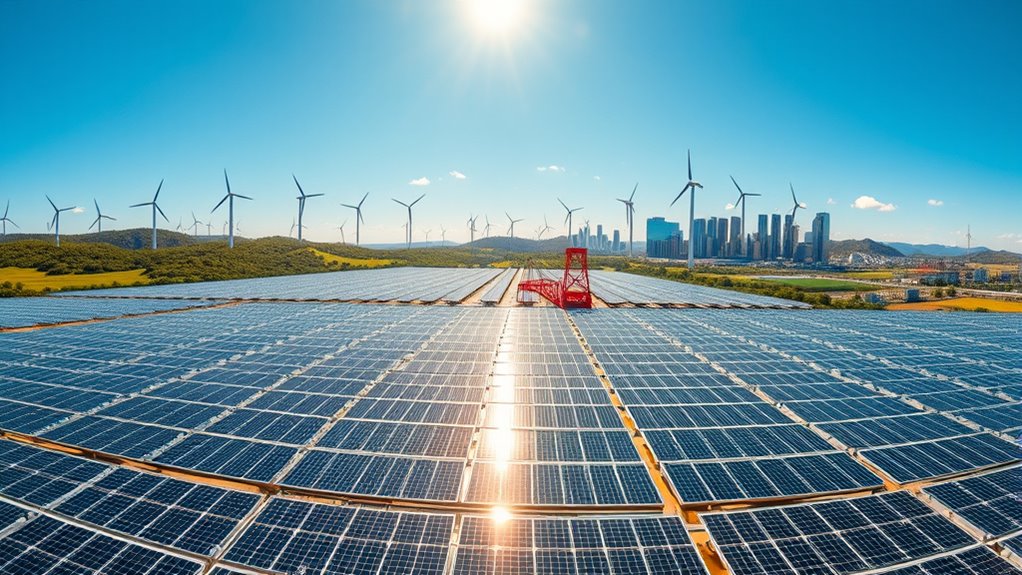The 2025 renewable energy boom teaches you the importance of managing market volatility through diversification and patience. It shows that long-term investments based on technological innovation, policy support, and demand can yield success. Staying informed about policy shifts and technological breakthroughs helps you adapt quickly and maintain an edge. Flexibility in reallocating resources and understanding regional differences are key. Keep exploring, and you’ll uncover even more insights to navigate this dynamic and promising industry effectively.
Key Takeaways
- Diversification across technologies and regions mitigates risks from market volatility during rapid renewable energy growth.
- Long-term strategic patience is essential to navigate technological breakthroughs and policy shifts effectively.
- Staying informed about policy incentives and regulatory changes enables proactive adaptation to market dynamics.
- Flexibility in reallocating investments to emerging sectors maximizes opportunities amid evolving technological landscapes.
- Managing market volatility through informed decision-making fosters sustainable growth and resilience in the renewable energy sector.

The 2025 renewable energy boom has transformed global markets and offers valuable lessons for policymakers and investors alike. As the sector experiences rapid growth, you quickly realize that market volatility has become a defining feature. Prices for solar panels, wind turbines, and related technologies fluctuate more than ever, often driven by geopolitical shifts, supply chain disruptions, and technological breakthroughs. This volatility can be unsettling, but it also creates opportunities if you adapt your investment strategies accordingly. Instead of seeking quick gains, you learn to diversify your portfolio, spreading investments across different renewable sources and regions. This approach helps mitigate risks linked to sudden price swings and policy changes, ensuring your holdings remain resilient amidst unpredictable market conditions.
Market volatility in renewable energy demands diversification and patience for resilient, long-term investments.
You also recognize the importance of timing and patience. During periods of high volatility, rushing into or out of investments can lead to losses. Instead, you develop a long-term perspective, understanding that the energy transition is a complex process that will encounter bumps along the way. This mindset encourages you to focus on fundamentals—such as technological innovation, policy support, and market demand—rather than short-term market noise. Additionally, you start leveraging data analytics and market forecasts to inform your decisions, helping you identify promising opportunities before they become mainstream. This strategic approach enables you to capitalize on emerging trends while avoiding the pitfalls of impulsive trading strategies. Moreover, understanding market volatility and its drivers helps you better prepare for sudden shifts and capitalize on favorable conditions. Recognizing technological breakthroughs can also signal key turning points in the market, allowing you to adjust your investments proactively. Staying informed about policy developments further enhances your ability to anticipate market shifts and adapt accordingly. Furthermore, keeping abreast of regulatory changes can prevent unexpected setbacks and open up new avenues for investment.
Furthermore, the boom underscores the need for flexibility in your investment strategies. As new technologies emerge and government incentives evolve, you adapt quickly, reallocating resources to sectors with the highest growth potential. You also pay closer attention to policy signals, recognizing that supportive regulations can profoundly influence market stability and profitability. This proactive stance allows you to stay ahead of market shifts, positioning yourself to benefit from new developments rather than reacting too late. You also understand that collaboration with other investors, government entities, and technology developers can provide additional stability and insight, helping you navigate the turbulent waters of the renewable energy market. Being aware of regional differences can further enhance your strategic planning and risk management.
In essence, the 2025 renewable energy boom teaches you that success depends on your ability to manage market volatility and refine your investment strategies accordingly. Patience, diversification, and staying informed are your best tools in a landscape characterized by rapid change and uncertainty. By embracing these lessons, you not only grow your investments but also contribute to a more sustainable future, aligning your financial goals with global environmental priorities. The key is to remain adaptable, vigilant, and committed to a long-term vision that recognizes the inherent risks and rewards of this transformative era.
Frequently Asked Questions
How Will Renewable Energy Impact Global Economic Inequality?
You might wonder how renewable energy affects global economic inequality. It can improve energy access for underserved regions, creating new opportunities. However, without policy reforms, wealthier nations or companies could dominate the market, widening the gap. To guarantee fairness, you need inclusive policies that promote equitable energy access, supporting developing countries and marginalized communities. This way, renewable energy becomes a tool to reduce inequality rather than deepen it.
What Are the Long-Term Job Prospects in Renewable Industries?
You’re likely to find promising long-term job prospects in green tech industries, as demand for renewable energy solutions continues to grow. These roles often offer good job security due to ongoing innovation and government support. By developing skills in renewable energy technology, you can position yourself for stable employment in evolving green tech sectors, ensuring a sustainable career path amid the global shift toward cleaner energy sources.
How Will Fossil Fuel Markets Adapt to Renewable Energy Dominance?
You’ll see fossil fuel markets adapt through decline and innovation, as fossil decline accelerates with renewable energy dominance. Market adaptation involves shifting investments toward cleaner energy sources, reducing reliance on traditional fuels. Companies will diversify portfolios and innovate in carbon capture and alternative fuels. This shift may lead to temporary volatility, but ultimately, the market will adjust to a sustainable energy landscape, emphasizing renewable sources and gradually phasing out fossil fuels.
What Infrastructure Investments Are Necessary for Sustained Growth?
Imagine you’re upgrading your energy system; to guarantee sustained growth, you need to invest in grid modernization and storage solutions. For example, a city like San Diego enhanced its grid to handle increased renewable inputs, preventing outages. You should prioritize flexible infrastructure that accommodates fluctuating renewable generation and energy storage, enabling reliable supply and supporting long-term renewable energy integration. These investments are vital for a resilient, sustainable energy future.
How Can Developing Countries Benefit From the Renewable Boom?
You can benefit from the renewable boom by leveraging solar subsidies to make solar energy more affordable and accessible. Investing in grid modernization guarantees reliable energy distribution, attracting investments and creating jobs. Developing countries should focus on policy reforms, capacity building, and partnerships to maximize these opportunities. By doing so, you’ll enhance energy security, foster economic growth, and reduce environmental impacts, positioning your country for sustainable development in the evolving global energy landscape.
Conclusion
As you reflect on the 2025 renewable energy boom, remember that investments surged by over 40%, proving that strategic policy can accelerate growth. This shift not only created thousands of jobs but also demonstrated how embracing green technology boosts economic resilience. Keep in mind, the rapid expansion highlights the importance of innovation and adaptability in shaping a sustainable future. By learning from this, you can better understand how proactive measures can turn environmental challenges into economic opportunities.
Amina brings over a decade of journalism experience to her role as Editor-in-Chief. Under her leadership, Exquisite Post has flourished, maintaining the highest standards of integrity and excellence. Amina’s commitment to truth and her visionary approach guide the editorial team in producing impactful news stories that resonate with our audience.










